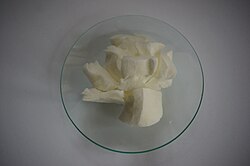Nitrocellulose
Appearance
| |||

| |||
| Names | |||
|---|---|---|---|
| Other names
Cellulose nitrate; Flash paper; Flash cotton; Flash string; Gun cotton; Collodion; Pyroxylin
| |||
| Identifiers | |||
| |||
| ChemSpider |
| ||
| Properties | |||
| (C 6H 9(NO 2)O 5) n (C 6H 8(NO 2) 2O 5) n (C 6H 7(NO 2) 3O 5) n | |||
| Appearance | Yellowish white cotton-like filaments | ||
| Melting point | 160 to 170 °C (320 to 338 °F; 433 to 443 K) (ignites) | ||
| Hazards | |||
| NFPA 704 |
| ||
Except where otherwise noted, data are given for materials in their standard state (at 25 °C [77 °F], 100 kPa). | |||
| Infobox references | |||
Nitrocellulose (also: cellulose nitrate, flash paper) catches fire quickly. It is formed by nitrating cellulose through exposure to nitric acid or another powerful nitrating agent. When used as a propellant or low-order explosive, it is also known as guncotton. Nitrocellulose can be plasticized by camphor. Kodak, and other suppliers, used placticized nitrocellulose as a film base in photograph, X-ray films and motion picture films. People call this nitrate film. After numerous fires caused by unstable nitrate films, safety film started to be used from the 1930s in the case of X-ray stock and from 1948 for motion picture film.
References
[change | change source]- ↑ Merck Index (11th ed.). p. 8022.



